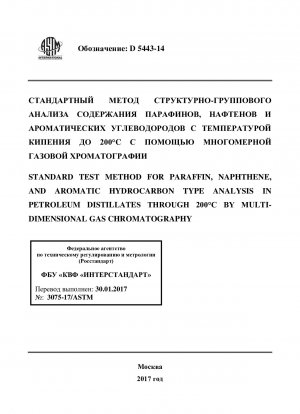ASTM D5443-14
Standard Test Method for Paraffin, Naphthene, and Aromatic Hydrocarbon Type Analysis in Petroleum Distillates Through 200 °C by Multi-Dimensional Gas Chromatography
- Standard No.
- ASTM D5443-14
- Release Date
- 2014
- Published By
- American Society for Testing and Materials (ASTM)
- Status
- Replace By
- ASTM D5443-14(2018)
- Latest
- ASTM D5443-23
- Scope
4.1 A knowledge of the composition of hydrocarbon refinery streams is useful for process control and quality assurance.
4.2 Aromatics in gasoline are soon to be limited by federal mandate. This test method can be used to provide such information.
1.1 This test method covers the determination of paraffins, naphthenes, and aromatics by carbon number in low olefinic hydrocarbon streams having final boiling points of 200 °C or less. Hydrocarbons with boiling points greater than 200 °C and less than 270 °C are reported as a single group. Olefins, if present, are hydrogenated and the resultant saturates are included in the paraffin and naphthene distribution. Aromatics boiling at C9 and above are reported as a single aromatic group.
1.2 This test method is not intended to determine individual components except for benzene and toluene that are the only C6 and C7 aromatics, respectively, and cyclopentane that is the only C5 naphthene. The lower limit of detection for a single hydrocarbon component or group is 0.05 % by mass.
1.3 This test method is applicable to hydrocarbon mixtures including virgin, catalytically converted, thermally converted, alkylated and blended naphtha.
1.4 The values stated in SI units are to be regarded as standard. No other units of measurement are included in this standard.
1.4.1 The abbreviation for SI unit “coulomb” is “C”.
1.5 This standard does not purport to address all of the safety concerns, if any, associated with its use. It is the responsibility of the user of this standard to establish appropriate safety and health practices and determine the applicability of regulatory limitations prior to use. Specific precautionary statements are given in Section 7 and Table 1.
ASTM D5443-14 Referenced Document
- ASTM D4057 Standard Practice for Manual Sampling of Petroleum and Petroleum Products
- ASTM D4307 Standard Practice for Preparation of Liquid Blends for Use as Analytical Standards
- ASTM D5134 Standard Test Method for Detailed Analysis of Petroleum Naphthas through n-Nonane by Capillary Gas Chromatography
- ASTM D6839 Standard Test Method for Hydrocarbon Types, Oxygenated Compounds, Benzene, and Toluene in Spark Ignition Engine Fuels by Multidimensional Gas Chromatography
ASTM D5443-14 history
- 2023 ASTM D5443-23 Standard Test Method for Paraffin, Naphthene, and Aromatic Hydrocarbon Type Analysis in Petroleum Distillates Through 200 °C by Multi-Dimensional Gas Chromatography
- 2018 ASTM D5443-14(2018) Standard Test Method for Paraffin, Naphthene, and Aromatic Hydrocarbon Type Analysis in Petroleum Distillates Through 200 °C by Multi-Dimensional Gas Chromatography
- 2014 ASTM D5443-14 Standard Test Method for Paraffin, Naphthene, and Aromatic Hydrocarbon Type Analysis in Petroleum Distillates Through 200 °C by Multi-Dimensional Gas Chromatography
- 2004 ASTM D5443-04(2009)e1 Standard Test Method for Paraffin, Naphthene, and Aromatic Hydrocarbon Type Analysis in Petroleum Distillates Through 200176;C by Multi-Dimensional Gas Chromatography
- 2004 ASTM D5443-04 Standard Test Method for Paraffin, Naphthene, and Aromatic Hydrocarbon Type Analysis in Petroleum Distillates Through 200176;C by Multi-Dimensional Gas Chromatography
- 2003 ASTM D5443-93(2003)e1 Standard Test Method for Paraffin, Naphthene, and Aromatic Hydrocarbon Type Analysis in Petroleum Distillates Through 200°C by Multi-Dimensional Gas Chromatography
- 1993 ASTM D5443-93(1998) Standard Test Method for Paraffin, Naphthene, and Aromatic Hydrocarbon Type Analysis in Petroleum Distillates Through 200176C by Multi-Dimensional Gas Chromatography
